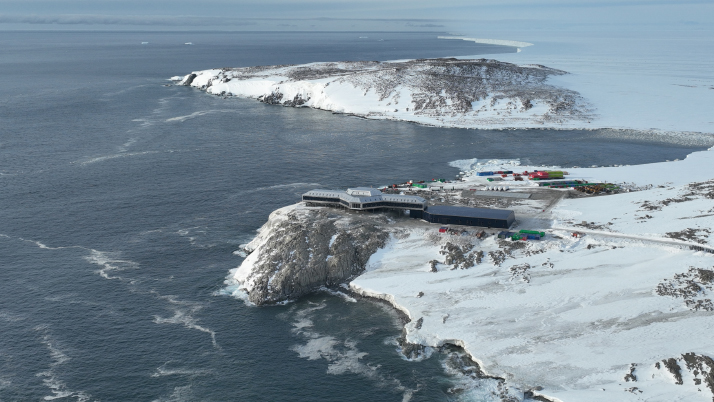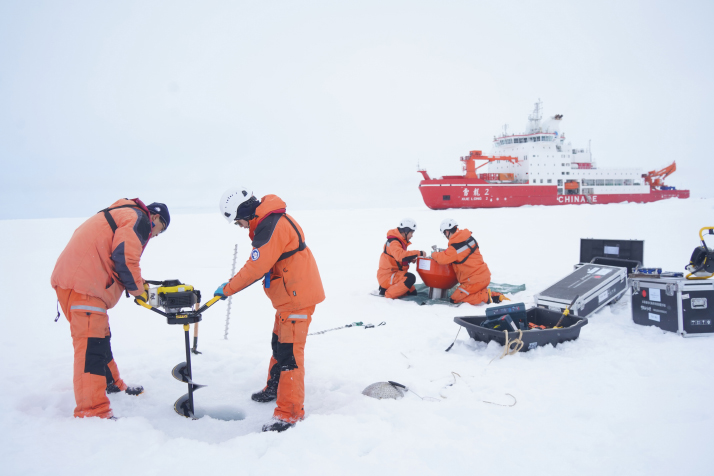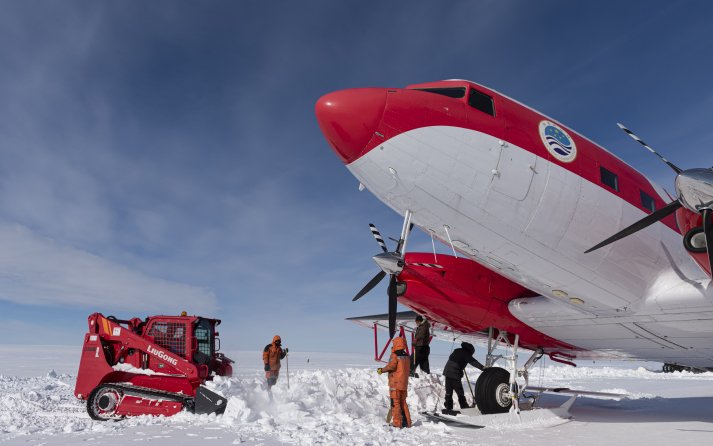
The triumphant return of the polar icebreaker the Xuelong, or Snow Dragon, to Qingdao, Shandong Province, on April 10 marked the successful completion of China’s 40th Antarctic expedition.
This significant five-month journey started from Shanghai on November 1, 2023 and reached Antarctica the same month. The mission utilized the capabilities of both icebreakers, the Xuelong and the Xuelong 2, as well as a cargo ship, to support the endeavors of over 460 researchers hailing from more than 80 Chinese institutions. Together, they traversed a staggering distance exceeding 150,000 km.
On April 15, the Xuelong docked in Shanghai. The Xuelong 2, carrying several members of the 40th Antarctic expedition team, returned to Shanghai a day later, after making its visit to Hong Kong.

The mission
A key achievement of this expedition was the construction of the Qinling Station, a new scientific outpost on Inexpressible Island in Terra Nova Bay, Antarctica. This station is China’s fifth research base on the continent, after the Changcheng, Zhongshan, Taishan and Kunlun stations.
Spanning 5,244 square meters, the Qinling Station is designed to operate year-round, accommodating up to 80 personnel during the summer months and 30 in winter. Engineered to withstand temperatures as low as minus 60 degrees Celsius and the harsh winds and corrosive sea-spray environment of the island, the station stands as a testament to China’s long-term commitment to polar research.
In addition to station construction, the 40th expedition’s researchers delved into a variety of scientific inquiries, particularly examining the impact of climate change on the Antarctic ecosystem. Xie Jian, deputy head of the expedition, shared with the media on April 10 that their exploration spanned the study of ecology, coastal waters, soil, geology, atmosphere, snow and ice, yielding numerous valuable findings.
He revealed that the team had successfully drilled through ice layers and the ice-bedrock interface to extract ice core and bedrock samples. This allowed them to collect critical data that had previously been lacking. Additionally, the team contributed to an international aerial survey program focused on the Enderby Land area.
Xiao Zhimin, the seasoned captain of the Xuelong 2, boasts a remarkable record of polar expeditions despite being under 40 years of age. With 18 polar voyages under his belt, including 10 to Antarctica and eight to the Arctic, Xiao has been at the helm for numerous pioneering moments in the history of China’s polar exploration. His experiences include leading the first circumnavigation of Antarctica and navigating through the Northeast Passage, Northwest Passage and Central Arctic Route.
“Polar exploration has transitioned from an age of natural adventure to a new epoch of scientific discovery,” he told Beijing Youth Daily. “Expeditions now reach farther into the unknown with greater operational precision, and the living standards for crew members have seen significant improvements.”
Xiao reminisced about his earlier days when weather forecasts for the westerly wind belt en route to Antarctica depended on rudimentary weather fax charts, weather data transmitted to ships by meteorological agencies, which lacked precision. It was not uncommon for the ship to experience rolls of up to 20 or 30 degrees. “Today, enhanced meteorological support enables the team to make accurate weather predictions and adjust their navigation to circumvent extreme conditions,” he said. “The Xuelong 2 is also outfitted with anti-rolling tanks, which mitigate lateral movement and enhance both comfort and safety on board.”
As China’s inaugural Antarctic expedition was made in 1984, this year is the 40th anniversary of Chinese polar research. To date, the nation has embarked on 40 Antarctic and 13 Arctic expeditions, amassing a wealth of samples and scientific data.
These multidisciplinary expeditions encompass a range of fields, including glaciology, marine biology, meteorology, geology and environmental science. China’s commitment to polar research is underpinned by its icebreakers, the Xuelong and the Xuelong 2, which serve as vital platforms for transport and fieldwork. These vessels empower Chinese scientists to access the most remote and inhospitable areas for research, even in extreme ice conditions.
The Xuelong 2 is China’s first domestically built polar icebreaker. Launched in 2019, it is a testament to the significant progress China has made in its capacity for polar research, building upon the legacy of its predecessor, the Xuelong, which has been in operation since 1993.
“The deployment of the Xuelong 2 signifies the dawn of a new chapter in China’s polar research initiative,” Xiao said. “The remarkable enhancement in the scope and depth of polar exploration would not have been feasible without the Xuelong 2’s formidable bidirectional icebreaking capabilities.”

Emerging talent
Xiao also highlighted the vital contributions of the younger generation of researchers during China’s 40th Antarctic expedition. Among them is Wu Xudong, a Ph.D. student from the Department of Environmental Science and Engineering at the University of Science and Technology of China, who joined the expedition team at the Changcheng Station.
“In this expedition, my primary research objective was to investigate the effects of historical climate change on the ecology of penguin populations,” Wu told China News Agency. “Merely relying on a few decades of observational data is insufficient to comprehend the fluctuations in penguin numbers within their habitats. It’s imperative to delve into their population dynamics over several millennia and to discern how penguins and seals have historically adapted to shifts in climate and their environment.”
Stationed at the base, Wu successfully gathered atmospheric data, seawater samples and biological fecal sediment cores. He noted that the gentoo penguin is currently the most prevalent species on Ardley Island, with an estimated count of 5,000 pairs. In contrast, species like the Adélie penguin are significantly less common, with a population of roughly 300 pairs.
Yet, two decades ago, Adélie penguins dominated Ardley Island. The swift warming of the Antarctic Peninsula has prompted their migration toward the southern extremities of the peninsula, while the gentoo penguins, more suited to the warming climate, have flourished and reproduced swiftly in this region, showcasing the stark impact of climate change on penguin populations and their succession.
“Antarctica is predominantly cloaked in fog and overcast skies, not as frigid as one might anticipate, but the winds are staggeringly forceful,” he said.
These intense winds further exacerbate sea conditions, injecting a high degree of unpredictability into their sampling efforts. At times, Wu and his team were pressed to cover five or six research sites within a single day, with each visit constrained by the demanding schedule.
Beyond the harsh weather, Antarctica harbors hidden perils beneath its surface. “While our sampling zones were relatively secure, the restricted ice cap regions can be deceptive; what seems like solid snow may disguise treacherous crevasses ready to ensnare the unwary,” he said.
For Wu, Antarctica represents an expansive, open-air university, brimming with scientific insights in every corner of its untamed wilderness.
In the Antarctic silence, one might occasionally perceive distant, thunder-like sounds. These are the reverberations of ice shelf collapses, part of the continent’s natural ice formation processes. “Venturing into the wilderness on a rubber boat allows me to intimately observe the details and patterns of the glaciers, including the numerous pint-sized penguins on the ice caps,” he said. “As these ice caps drift and dissolve, they liberate copious amounts of fresh water and carry nutrients that draw and support large populations of krill, which in turn attract penguins to feast on them. This is the life-giving force of the glaciers.”
On the day of Wu’s departure from Antarctica, the skies were aglow with radiant, rose-tinted light. He said he considered it Antarctica’s parting gift to him. “To me, Antarctica is not only a realm of breathtaking vistas but also a place of relentless perseverance despite exhaustion,” he said. “It is home to endearing wildlife, an abundance of scientific riches, the kindest of companions, and a profound, tranquil vastness.”

The other pole
China stands as one of the small group of nations actively engaged in exploration at both poles, with its interests in the Arctic encompassing the potential impacts of climate change, the prospect of new maritime routes, and the exploitation of the region’s abundant natural resources.
In 2004, China inaugurated the Yellow River Station in Svalbard, Norway, marking its first foray into Arctic research infrastructure. This facility has become a cornerstone for Chinese researchers to pursue diverse scientific endeavors, spanning glaciology, atmospheric sciences, biology and geology.
Early in 2018, China articulated its Arctic policy, delineating its dedication to the peaceful utilization, comprehension and conservation of the Arctic. This policy underscores the importance of scientific inquiry, environmental stewardship and global collaboration.
“Polar research is increasingly critical in tackling the challenges posed by global climate change,” He Fang, leader of the Yellow River Station, told Xinhua News Agency. Last summer, he devoted over two months to research at the station.
Throughout the years, drawing on their Arctic studies, Chinese scientists have disseminated a wealth of research on a spectrum of Arctic subjects, including the dynamics of sea ice, atmospheric chemistry, and the impacts of climate change on the region’s ecosystems.
“The Arctic’s distinctive natural conditions and strategic geographic positioning endow it with a pivotal role in the discourse of global change,” he said. “Through its Arctic explorations, China is committed to enhancing the collective understanding of the Arctic’s influence on global climate patterns, advocating for the sustainable development of the region, and nurturing international partnerships in the High North.” –The Daily Mail-Beijing Review news exchange item




